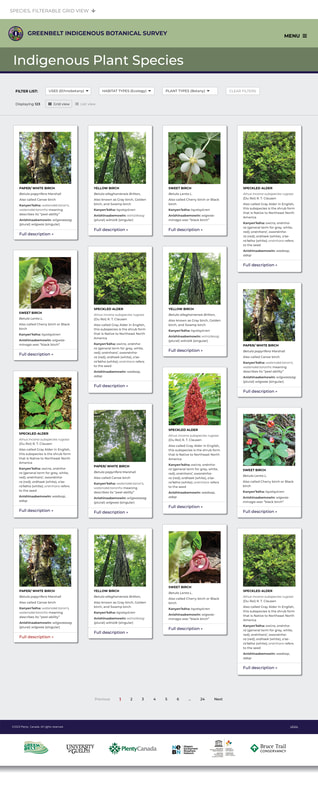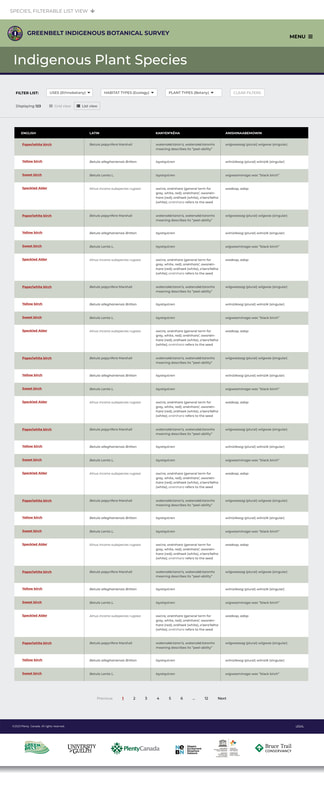|
A significant new educational resource that blends Indigenous ethnobotanical knowledge with Western science is being prepared for release later this month. Resulting from three + years of planning, research, and collaboration by Plenty Canada and the University of Guelph, with the involvement of Brock University, Niagara Escarpment Biosphere Network, and Bruce Trail Conservancy, the Greenbelt Indigenous Botanical Survey will feature a listing of Indigenous plants identified at 23 Indigenous historic sites throughout Ontario's Greenbelt. Stay tuned for the URL link that will be announced later on the Plenty Canada website. Appreciation to the Greenbelt Foundation for its support of this project.
This is a very unique project that combines the gifts and skills of Indigenous community ethnobotanists, linguists, academic researchers, and educators who conduct community-based research. The project integrates anthropological research (the cultural components of ethnobotany), Indigenous linguistics, and plant biology research, to communicate broad and deep information about the past, present, and future of Indigenous human geography within the Greenbelt. The project follows Indigenous methodologies and research ethics, and uses rigorous science and archival research in service of both conservation and Indigenous knowledge revitalization. It took several years to carefully build out the project’s research parameters and goals, and a great deal of care was put into details to achieve high-quality results. Through the research and knowledge of Dr. Jessica Dolan and the Plenty Canada and University of Guelph team, it became apparent that the Greenbelt is an undeniable resource containing Indigenous plant species that need to be conserved while connecting to issues such as biodiversity, climate change, and other matters. Through the application of the philosophy of Two-Eyed Seeing, we can blend scientific knowledge with ethnographic information leading to increased understanding and awareness of the value of Indigenous plant life within the Greenbelt, and the bonds between plants and people. Twenty-three location profiles were surveyed which identified hundreds of Indigenous plant species. Four hundred and fifty-two vascular plant species were recorded in 2022, with 1,204 herbarium voucher specimens mounted, scanned, and accessioned to the University of Guelph herbaria. Data Analysis for each research plot was assigned a vegetation community type classification following Ecological Land Classification (ELC) for Southern Ontario. Cross-referenced plant lists derived from the field surveys were integrated with Dr. Dolan’s database of Haudenosaunee and Anishinaabe ethnobotanical plants. The work also included computed diversity indices for the entire plant community recorded at research plots, as well as for a subset of species that are culturally significant. Univariate and multivariate statistical procedures were used to test for differences in ethnobotanical species richness between ecosystem types in the Greenbelt, and to characterize how ethnobotanical plants are distributed across these ecosystems. All these documented research methods, findings, and implications for biocultural conservation will be stored in the University of Guelph Atrium. The Greenbelt Indigenous Botanical Survey will have applications for educational curricula that link Indigenous knowledge with Western science. — Project team
0 Comments
Your comment will be posted after it is approved.
Leave a Reply. |
|
-
Home
- Donate
-
Projects
-
Canada
>
- Niagara Escarpment Biosphere Network
- Great Niagara Escarpment Indigenous Cultural Map
- Greenbelt Indigenous Botanical Survey
- The Healing Places
- Indigenous Food Sovereignty
- Plenty Canada CampUs
- Two-Eyed Seeing Bird Knowledge
- Indigenous Languages and Cultures Programs >
- Wild Rice
- Good Mind Grappling
- Ginawaydaganuc Village
- Youth Programming >
- Caribbean >
- Central & South America >
- Africa >
-
Canada
>
- News
- Resources
- Partners
- Contact Us
Our LocationPlenty Canada 266 Plenty Lane Lanark, Ontario, Canada K1G 3P4 (613) 278-2215 |
Donate to Plenty Canada |
Subscribe to our Newsletter |





